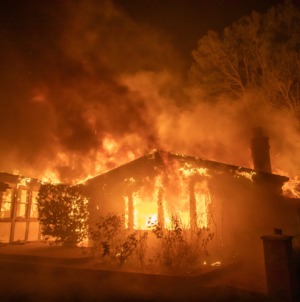-
California SNAP Benefits Get New Update as Wildfires Ravage Los Angeles - 15 mins ago
-
Genesis Invitational host Tiger Woods says people ‘lost everything’ in fire - 18 mins ago
-
Jessica Tisch Tries to Tame the N.Y.P.D. After a Period of Tumult - 26 mins ago
-
Rare Roman Gold Coins Worth $322,000 Found in Luxembourg - 51 mins ago
-
Washington Post Employees Plead With Jeff Bezos to Meet - about 1 hour ago
-
Woman Calls Out Relatable Feeling That Makes No Sense as an Adult - about 1 hour ago
-
FDA Bans Red Dye 3 in Foods, Linking It to Cancer in Rats - 2 hours ago
-
What CPI Report Could Mean for Donald Trump - 2 hours ago
-
Fires break out amid Santa Ana winds in Riverside County - 2 hours ago
-
Woman From Tropical Country Starts ‘Ugly Crying’ at First Sight of Snow - 3 hours ago
Blood Moon: When and How To See the Lunar Eclipse
The moon is expected to turn an eerie blood-red above the skies of the U.S. in the coming months, due to a rare total lunar eclipse.
Late on March 13 and in the early hours of March 14 this year, 13 percent of the world’s population will fall in the path of a total eclipse of the moon, with the Earth totally blocking out the light of the shine shining onto the full moon.
While a solar eclipse involves the moon passing between the sun and the Earth, casting a shadow across our planet, a lunar eclipse involves the Earth passing directly between the moon and the sun.
This alignment prevents sunlight from directly reaching the moon, which is why the moon appears darkened or takes on a reddish hue. Lunar eclipses are therefore sometimes called “blood moons.”

Darrian Traynor/Getty Images
“When Earth is positioned precisely between the moon and sun, Earth’s shadow falls upon the surface of the moon, dimming it and sometimes turning the lunar surface a striking red over the course of a few hours,” NASA explains.
The reddish hue during a total lunar eclipse happens because sunlight passes through Earth’s atmosphere, which scatters blue light and allows red wavelengths to reach the moon, an effect known as Rayleigh scattering.
When is the next blood moon?
The lunar eclipse will begin at 2:26 a.m. local time in New York during the early hours of March 14, hitting its maximum at 2:58 a.m., before ending at 3:31.
In Los Angeles, the eclipse will begin at 11:26 p.m. local time, peak at 11:58 p.m. and ends at 00:31 a.m.
How long does a lunar eclipse last?
The entire event of the Earth passing in front of the moon—with the moon entering the Earth’s umbra (the central, darkest part of the shadow) and penumbra (the lighter outer shadow)—can last up to 3–4 hours.
However, the totality phase—when the moon is fully within Earth’s umbra and appears reddish—typically lasts between 30 minutes to 1 hour 40 minutes, depending on how close the moon is to the Earth at the time.
The upcoming eclipse’s totality will last about 65 minutes.
Why don’t we have a lunar eclipse every month?
A lunar eclipse can only happen during a full moon, when the moon is on the opposite side of Earth relative to the sun.
However, the moon’s orbit around Earth is tilted about 5 degrees relative to Earth’s orbit around the Sun. This is why lunar eclipses don’t occur every full moon—they only happen when the moon’s orbit aligns with Earth’s shadow during a full moon.
“The moon’s orbit is tilted about 5 degrees compared to the plane of Earth’s orbit around the sun. Because of this tilt, the moon as seen from Earth’s perspective usually passes above or below the sun when it passes between us and the sun,” NASA explains.
“The tilt of the moon’s orbit prevents us from having monthly solar and lunar eclipses.”
After this eclipse, the next total lunar eclipse will occur in September this year, but only be visible over Central Asia and Europe. The next lunar eclipse visible from the U.S. will fall on March 2–3, 2026.
Do you have a tip on a science story that Newsweek should be covering? Do you have a question about lunar eclipses? Let us know via science@newsweek.com.
Source link






















